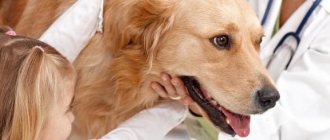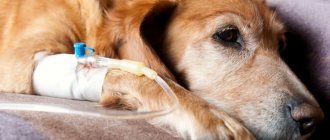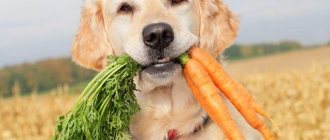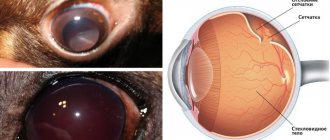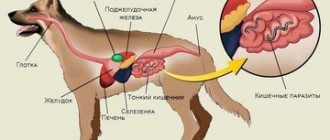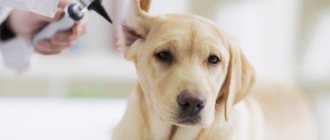Many people don't even think that dogs can be obese. “This is an animal, what are you talking about?” - a common response to the words that the dog is overweight.
Another category of people see that their pet is clearly obese, but they answer: “I like him, he’s such a funny fat guy.”
Neither one nor the other wishes harm to their pet. They simply do not know that obesity worsens the quality of life of a pet, and in serious cases, leads to serious and life-threatening illnesses.
Obesity is a pathological condition that is characterized by excess fat deposits and leads to changes in body functions.
Causes of obesity
There are many reasons why a dog becomes overweight. They may be related:
- with genetic characteristics;
- diseases predisposing to obesity;
- irresponsible attitude of the owner towards his pet.
The most common reasons:
Overfeeding
In each article, we tirelessly repeat how important a correct, high-quality and balanced diet is for a dog, be it dry food or natural food. It is appropriate to add here that feeding should also be moderate.
Some people think that by feeding a bunch of treats to a dog, they are expressing their love for their four-legged friend. But the best manifestation of love is caring for your pet’s health.
Low animal activity
When getting a dog, every person should understand that it is necessary to walk with it. And not 15 minutes a day for her to “do her business” and run home.
The animal needs activity, it needs to be played with, allowed to run and provided with the necessary exercise.
It is very important to understand that any dog needs a certain amount of exercise and activity, regardless of breed.
Of course, you don't need to run around with a Chihuahua as much as you would with a German Shepherd, but none of them should lie around the house all day.
Drugs
The use of certain medications can lead to excess weight gain.
These drugs include antiepileptic drugs and glucocorticoid drugs. In this case, it is called Iatrogenic obesity.
Metabolic disease
Metabolic pathologies can be acquired (due to some disease), or they can be genetically determined.
The genetic factor is that the mechanism of regulation between energy intake and expenditure in dogs is adapted to “wild” conditions. And at home, when food is abundant and living conditions are very limited, the genes regulating this mechanism practically stop working.
The exact reasons for this are poorly understood, but it may explain the predisposition of certain breeds to obesity.
Stress
Yes, not only people “eat stress.” Animals can also have this tendency. One of the reasons why a dog may experience stress is having a second pet.
Or rather, feeding two or more dogs together. Especially if one of the dogs shows clear leadership, and the other is in constant tension because of this. In such cases, it is necessary to feed them separately.
In any situation involving stress in a dog, the owner plays a key role. If you treat your pet attentively and feed him according to the norm, without giving in to his cute “begging” face, then everything will be fine.
Remember that most often dogs have no sense of proportion.
Predisposition
So, which dogs are most likely to be overweight?
Breed predisposition.
The root cause of this predisposition varies among different breeds. For example, some small dogs tend to overeat due to excess energy (a little controversial, but true), and large breed dogs are more likely to gain weight due to osteoarticular diseases. Dog breeds predisposed to obesity (from small breeds to large ones):
- Cairn Terrier;
- Dachshund;
- Cavalier King Charles Spaniel;
- Scottish Terrier;
- Beagle;
- Cocker Spaniel;
- Basset Hound;
- Collie;
- Golden Retriever;
- Labrador Retriever;
- Rottweiler;
- Bernese Mountain Dog;
- Newfoundland;
- Saint Bernard
Among these breeds, Labradors are definitely the favorite in terms of their tendency to be overweight.
Age
The tendency to become overweight in dogs increases with age (by the way, not only the pet itself, but also its owner). On average, dogs are diagnosed with obesity between the ages of 5 and 8 years.
Castration
There are statistics according to which the incidence of obesity in neutered dogs is twice as high as in non-neutered ones. This is especially true for castrated females.
But nevertheless, there is no direct effect of sex hormones on metabolism. They either influence body weight through the nervous system or indirectly alter cellular metabolism.
The issue is controversial, but it is absolutely established that sufficient physical activity after castration prevents weight gain.
CHAPTER 3. NUTRITION FOR AN OVERWEIGHT DOG.
The main factor in weight gain, in addition to physical inactivity characteristic of urban animals, is nutrition. For dogs on dry food, you need to choose its composition very carefully. Many owners make the mistake of relying on the dosages listed on the package of ready-made dog food. This is incorrect, only approximate theoretical norms are given there; one must focus exclusively on the condition of the animal, the loads received, risk factors in terms of obesity, such as castration, adulthood, as well as living conditions (apartment, enclosure) and time of year.
The composition itself is no less important; the more grains and ballast fillers in the food, such as corn gluten, yeast, beet pulp, wheat, yeast, the faster weight gain will occur. It is also important to control the ratio of protein, fat and carbohydrates in the feed. If you want your dog to lose weight, choose lightweight food with one type of high-quality protein - lamb, deer, duck, salmon, a minimum of cereals and a sufficient amount of vegetables in the composition. A good example is Barkin Heads “Losing Fat Man”, GOU “Lamb with brown rice”, etc. There is no need to go on a diet, but make sure that protein, and most importantly fat, do not exceed the ratio: 22-24 / 12-13%.
For medium-large breeds, it is sometimes better to replace several feedings per week with raw meat, cottage cheese, sea fish or kefir. Give vegetables, unsweetened fruits and greens in small quantities daily.
On a natural diet, you should give up cereals and increase the proportion of fresh vegetables, especially those that help normalize the intestines and burn fat - cabbage, beets, zucchini, pumpkin.
Reduce your normal daily diet, but not immediately, but by 1/4. Feed your dog fractionally, like a puppy, dividing the usual daily portion into 3-4 feedings. Make sure that an overweight dog receives no more than 30 calories per day per 1 kg of weight!
Completely remove foods rich in simple carbohydrates, bread, cereals, and pasta from your diet. If tolerated normally, replace one of the 3 feedings with low-fat kefir. Introduce one fasting day per week when the dog receives nothing but kefir and a small green apple or fruit salad. Reduce the proportion of fat in your diet, choose leaner meat, low-fat sea fish, give up fatty trimmings, beef cheeks, udders and chicken hearts. Give black, unpeeled tripe and flank meat more often, choose cottage cheese no higher than 3.5%, and take kefir 1-2.5%, do not give completely low-fat products.
Adjust the portion of food depending on the load on that day and time of year. In hot weather, reduce the portion, in winter increase it, feed a working and kennel dog more nutritiously than a couch potato. Introduce more raw meat, low-fat varieties of sea fish, low-fat cottage cheese and kefir, and vegetables. Add flaxseed oil to your diet - no more than 1 teaspoon, greens, such as young nettle and dandelion leaves, seaweed. Bran is also required as a source of coarse dietary fiber.
Remove from your diet foods such as cheese, udders, cheeks, red fish (temporarily), butter, milk, bananas, cream, all types of baked goods, potatoes, legumes, human baby food and canned food, and temporarily stop taking vitamins. Regardless of the type of food, the diet should not include table food, store-bought treats, soups, or fried foods!
To regulate metabolic processes in the body, you can add L-carnitine to the diet, and a probiotic, the same “Narine” or “Lactobifadol”, in the morning feeding. It is very useful to give fresh curd whey.
A great way to temporarily move all the food outside and feed only for work and good behavior. There is no need to be afraid of the danger of bloat, since you will be feeding food in small portions, but do not forget to take a break and always carry water with you. Naturally, you should not run cross-country after this!
Types of obesity
There are mainly three types of obesity:
- Nutritional – directly related to overeating.
- Endocrine obesity is associated with certain diseases, such as diabetes mellitus or hyperadrenocorticism. This is actually a difficult question, everything here is confusing. Just as diabetes can provoke obesity, and vice versa, excess weight provokes diabetes and other endocrine disorders.
- Iatrogenic obesity is a consequence of taking certain medications that either affect metabolism or increase appetite.
Symptoms and degrees of obesity
To determine the degree of obesity, you need to know how the quality (index) of the body (somatic status) is generally assessed.
Numbers are used for this. Thus, if an animal has normal weight, then fat mass makes up 13% of the entire body. An obese dog is 40% overweight, while a wasted dog is 20% below optimal body weight.
There are several types of body weight assessment:
- 3 degrees: 1 - below normal, 2 - normal, 3 - above normal. A very vague assessment, uninformative, so it is practically not used.
- 5 degrees: 1 - exhaustion, 2 - below normal, 3 - normal, 4 - above normal, 5 - obesity. In practice, this scale is most often used.
- 9 degrees: from 1 to 4 = from emaciated to below normal, 5 - normal, from 6 to 9 = from above normal to obese.
To more accurately understand the condition of the dog, intermediate indices are used.
On a five-step scale, grade 4 means the dog's body weight is 20% higher than normal, and grade 4.5 means 30% higher than normal.
To make it easier to understand, use the table:
| Degree | External changes |
| Exhaustion - body weight below optimal by more than 20%. |
|
| Below normal - body weight is 10-20% below optimal. |
|
| Optimal body weight. |
|
| Above normal - 10-20% excess weight. |
|
| Obesity - 40% excess weight. |
|
Symptoms of obesity:
- Fat deposits (their degree and location are presented in the table).
- The last two ribs are not visible during movement (normally their outlines should be visible, since they do not connect to the sternum).
- Heavy breathing even after light exertion.
- Change in gait.
- The paws visually appear shorter.
- Arching in the back (not natural).
Consequences
Diseases of the musculoskeletal system . Any of the pathologies of the musculoskeletal system can overtake an obese dog, mainly due to excess stress on the joints.
It is especially worth noting similar pathologies in young dogs of large breeds. The fact is that overfeeding puppies that are in the growth phase entails the development of various orthopedic diseases, including worsening hip dysplasia (especially common in German shepherds). The effects of excess weight can appear in dogs as early as the first year of life.
Pathology of the cardiovascular and respiratory systems . Obesity is accompanied by hypertension, tachycardia and general disturbances in the functioning of the heart, and as a result of breathing.
Diabetes . Obesity causes significant changes in glucose metabolism and insulin secretion (formation). Moreover, the absorption of glucose and the secretion of insulin worsens the more the body weight increases.
Hyperlipidemia and dyslipidemia . Simply put, a disorder of fat metabolism, including obesity, provokes fatty degeneration of the liver.
Urinary incontinence and urolithiasis . There was also an increase in kidney mass in overweight dogs.
Thyroid dysfunction.
Symptoms
You can tell if your dog is obese simply by looking at it.
Obesity in dogs has almost the same symptoms as in humans. The main ones include:
- sagging belly, due to which the dog begins to hunch;
- lack of differentiation between the chest and peritoneum;
- visual shortening and thickening of the paws;
- formation of fat folds not specified by breed;
- severe shortness of breath;
- lethargy;
- decreased sexual activity in males and irregular estrus in females.
If the problem is ignored, the dog may develop serious pathologies that require drug treatment.
Palpation will help you verify if your dog is overweight at home. During examination, the dog's last two ribs should be clearly palpable. If they are hidden under a layer of fat, then this sign indicates the development of obesity.
The above symptoms are not characteristic of obesity and may be signs of another disease. That is why, if they are detected, you should consult a veterinarian. In no case should treatment be delayed, since at an early stage it is much easier to get rid of excess weight with the help of a special diet.
Treatment
To cure obesity in a dog, you don’t need to discover America. The process is simple, but it requires a lot of effort and time from the owner.
If the owner approaches this issue responsibly, you will soon notice progress.
Recipe for losing excess weight:
- Adjust nutrition.
- Add active physical activity.
However, not everything is as simple as it might seem at first glance.
Firstly, you must first find out the reason for gaining excess weight. Secondly, assess the consequences.
Often it is no longer possible to manage with a simple diet. If there is a possibility that functional changes have occurred in the body (and there is always such a possibility), drug treatment may be required.
Important! Before taking any action, you need to take your pet to a veterinarian for examination.
Diet is an integral step to getting rid of obesity. However, you need to approach this step wisely. You cannot simply deprive your dog of food indefinitely.
You can't let your dog go hungry!
If you feed your dog dry food, then you need to switch to another food from the medicinal line. There are special dietary ready-made foods. They retain the required amount of macro- and microelements, vitamins, and at the same time reduce calorie content.
If you feed your pet natural food, everything is a little more complicated. You will definitely have to change your dog's diet.
Ideally, you should seek help from a veterinarian who will create a diet specifically for your pet.
In this case, the diet is compiled taking into account the characteristics of the dog and based on your capabilities (from those products that you are ready to feed your pet). You can request this service in person. if possible, find a specialist online (only you must be sure that this is a specialist in front of you!).
With any type of feeding, when you put your pet on a diet, discipline is very important.
It is your discipline. You must understand that the dogs' health depends on you, so you need to strictly monitor portion sizes.
Treatment of obesity in dogs
Obesity in dogs is an excess of an animal's body weight by 30% of normal. This condition must be treated without fail, preferably under the supervision of a veterinarian. It is good if the doctor prescribes treatment, diet and exercise for your dog. It happens that if all recommendations are followed, the dog’s weight remains the same or continues to increase. This suggests that the cause of obesity is problems with internal organs. The dog will begin to gradually lose weight when the cause of the disease is determined and treatment is begun to eliminate it.
Special food for a sick dog should be prepared by a veterinarian.
Meal frequency is usually prescribed:
- for large dogs - 3 times a day;
- for small breeds - up to 4 times a day;
- for adult dogs - 1 time per day.
The diet consists of the dog eating the following foods:
- - lean meat;
- - low-fat fish;
- - vegetables (raw, boiled);
- - fruits (unsweetened);
- - dairy products;
- - cereals (exception - rice).
The dog is prohibited from eating any sweets, flour products, sausages, fried and salty foods. Human food should not be given to dogs.
If you feed your dog industrial dry food, you should switch to a special dietary food for dogs with obesity. You cannot feed your dog economy class food, as it has a very poor composition that does not meet the dog’s needs.
In addition to a diet for dogs with obesity, the veterinarian may prescribe medications to reduce the feeling of hunger. By taking medication, the dog can control hunger and begin to lose weight. However, you cannot prescribe inexpensive but effective medications for your dog on your own; this should be done strictly by your attending physician.
In addition to diet and medications, it is necessary to organize physical activity for an obese dog. Of course, you can’t immediately give her serious loads. To begin with, you just need to take walks, gradually increasing the time. After the dog gets used to the activity, it is necessary to add running, swimming or playing with a ball. If you cannot train with your dog, you can contact a dog trainer who will develop a program for your pet and train it in a special area where there are devices for quick weight loss.
REFERENCE! If obesity is left untreated, it can lead to lipidosis - fatty liver, which in turn can lead to serious consequences and even death for the dog.
Weight control
To maintain optimal condition, veterinarians often recommend monthly weighing and recording of its results.
Exercise stress
You don’t need to give it a marathon as soon as you realize that your dog needs to lose weight. The dog should not lose weight too quickly. Start with longer walks so that your dog spends more time outside and moving. Then gradually give her more load.
Difficulties may arise in cases where the dog has already experienced disorders in the musculoskeletal system due to excess weight. Then naturally, the animal will refuse unnecessary movements. A veterinarian will help solve this problem, but your pet will need additional care, and you may have to take it for special procedures.
Relieving a pet of excess weight is entirely the responsibility of the owners.
Diagnostics
The appearance of the signs listed in the section “How to understand that a dog is obese” is a reason for an urgent visit to the veterinary clinic. It is important to find out what stage of the pathological process the dog has, what complications develop against the background of excess weight.
The veterinarian compares the actual body weight with the standard for a particular breed and identifies the level of deviations. It is important to take into account the individual characteristics of the dog (height to weight ratio - body mass index) if the pet is not purebred.
A mandatory element of diagnosis is a detailed conversation with the dog’s owner, finding out the type of food, diet, bad habits (begging, stealing food from the table), and the pet’s activity level. Often, already at the first stage, the doctor understands the cause of obesity in his four-legged friend.
Exceeding the actual readings when compared with the norm is a reason for additional examination of the pet. Often the animal has problems with joints, liver, and hormonal levels. The veterinarian will order a blood test to check cholesterol levels and liver enzymes. It is important to understand whether there are endocrine pathologies that often accompany obesity. Conducting an ultrasound of the abdominal organs, thyroid gland, blood tests for hormones and glucose levels are additional diagnostic methods.
Prevention
Remember one golden rule - rather than treating a disease, it is better to prevent it!
To prevent your pet from becoming obese, you need to follow some rules from the very beginning of his puppyhood:
- Take a responsible approach to feeding your dog, be it dry food or natural food. The diet should be balanced, and the portion should not exceed your pet’s norm.
- If you are not ready for long walks every day, it is better not to get a dog at all.
- You need to monitor your pet’s health and maintain its immunity at a high level. This requires annual vaccination and periodic treatments against internal and external parasites.
Food for obese dogs
Industrial food for obese dogs is specially formulated in such a way that it maintains the required level of nutrients and vitamins, but at the same time reduces the calorie content.
Dietary food lines are available from various manufacturers.
The most popular of them:
- Royal Canin.
- Pro Plan.
- Hill's.
These manufacturers have a wide selection of feeds. Even diet food for obese dogs comes in a wide range: from food for small breeds to diets for large breed dogs.
However, just starting to pour new food into the bowl is not enough. It is necessary to carry out calculations and calculate the daily serving size specifically for your pet, taking into account current and desired weight, body fat percentage and the required rate of loss.
Briefly about the main thing
- Obesity is a pathological condition, in other words, a disease that leads to serious disorders in the body and shortens the life of a pet.
- Causes of obesity: overfeeding the dog, endocrine diseases, and taking certain medications.
- Some dog breeds and older individuals are at risk.
- Obesity in dogs leads to many diseases that can affect all systems of the body: pathologies of the musculoskeletal system, disorders of the heart, difficulty breathing, endocrine diseases.
- In addition to obvious external signs of excess weight, with obesity, changes in the behavior and general condition of the dog are observed: passivity, shortness of breath, strange gait.
- Before starting treatment, an examination by a veterinarian is required to determine the stage and consequences of excess weight.
- The dog must lose weight gradually, so you need to approach diet and exercise wisely.
What does obesity lead to?
According to statistics, about a third of pets are overweight. This is dangerous: it increases the load on all organ systems, which can lead to more serious disorders and diseases, including diabetes and cancer.
Overweight animals suffer from arthritis because the weight puts additional stress on the musculoskeletal system. Over time, it becomes more difficult for pets to be active. A vicious circle is formed: the animal moves less, and this further contributes to the development of obesity.
Excess weight puts stress on the circulatory system. The load on the heart increases, and this can lead to pulmonary and cardiovascular diseases.
